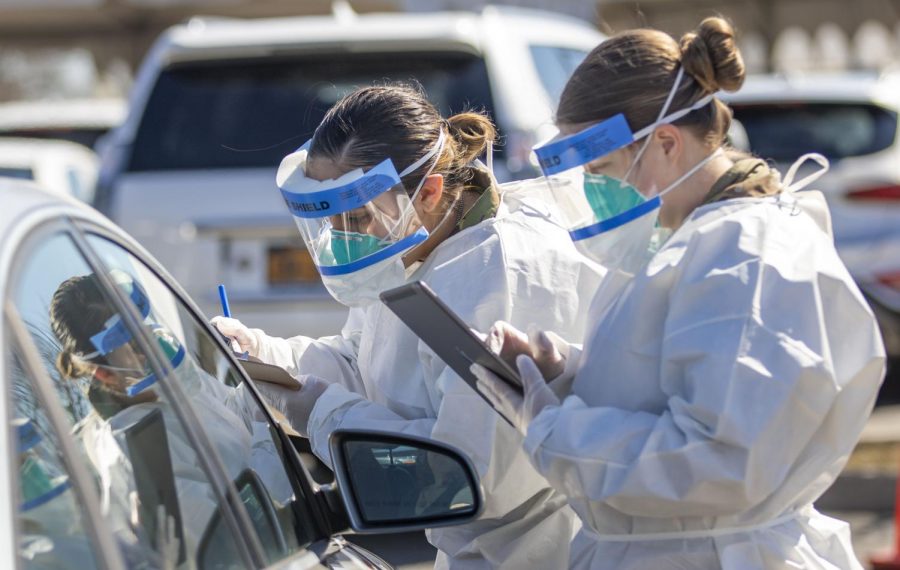Breaking down COVID-19 (novel coronavirus) misinformation
Photo credit: New York National Guard by Sgt. Amouris Coss licensed under CC BY 2.0.
Members of the military register people at a COVID-19 Mobile Testing Center in Glenn Island Park, New Rochelle, Mar. 14, 2020. Members of the Army and Air National Guard from across several states have been activated under Operation COVID-19 to support federal, state and local efforts.
April 14, 2020
The questions in this article were generated from a Google Form that was sent to all students and faculty.
How is COVID-19 affecting Archer and the Los Angeles area?
As a result of the spread of COVID-19 (novel coronavirus), starting March 17, Archer moved to remote learning using online platforms like PowerSchool Learning Hub and Zoom until further notice.
In addition, Archer Abroad trips to France and Mexico as well as ninth and seventh grade Arrow Week were canceled. Other events, such as Lit &…Conference, are postponed, and the spring athletic season is under review. The Oracle will continue to report live updates regarding Archer.
As for the greater Los Angeles County, according to the County of Los Angeles Public Health, there have been 10,047 reported cases and 360 reported deaths COVID-19. The Los Angeles Times is currently tracking the virus in California specifically. Read here for statistics on COVID-19 in California, a breakdown of cases in Los Angeles County, how many tests are being issued, etc.
What does quarantine mean? Will officials declare a nationwide quarantine?
Since COVID-19 is spreading across the globe, many people are practicing different types of social-distancing to stop or slow down the spread among communities as well as ensure that hospitals and health care facilities can maintain an adequate amount of supplies, beds and health care providers to care for patients.
Social-distancing is intentionally increasing the physical space between people to avoid the spread of contagious illness and overwhelming the health care system. Cancellations of events that will attract larger crowds, working from home, closing schools, switching to online classes, not visiting others, etc. are all examples of social-distancing.
Self-quarantine and isolation, other terms that have recently been thrown around, are specific forms of social-distancing.
Self-quarantine is when people who have been exposed to the virus or are at risk of getting infected are restricted and separated from people in order to determine if they will become ill. Self-quarantine usually lasts two weeks and involves staying at home without having any visitors, staying six feet away from other people in the same household, etc.
Isolation is when someone has been confirmed to have the virus and is separated from others. Isolation is mostly a health care term, but it can take place in a home or at a healthcare facility. It demands more special personal protective equipment like specialized clothing when treating someone. If you are sick with COVID-19, the Centers for Disease Control and Prevention recommend following these steps that include staying home except to get medical care and calling ahead when visiting a doctor.
According to the CDC, quarantine and isolation are also a “police power” in the United States. The federal government acquires authority to order isolation and quarantine from the Commerce Clause in the U.S. Constitution. This authority has been delegated to the CDC to carry out more daily functions. States and tribes also have different police power authority to “protect the health, safety, and welfare of persons” within their borders or on their lands. Read here for more information on what the federal government, the CDC, state/local governments, and tribes are specifically entitled to when it comes to quarantine and isolation orders.
There have been rumors of the Trump administration issuing a “nationwide lockdown” or “regional quarantine,” but that is unlikely. The CDC says that large-scale isolation and quarantine are rarely used, and the National Public Radio says it is “likely not legal.” Legal experts in the NPR article say that the federal government does have the power to prevent the spread and entry of communicable disease from foreign countries into its borders or in between its states–for example, limiting travel — but its options are limited. Large scale quarantine and isolation from the “White House can be advisory only and those are exclusively state powers.”
For example, in California, Governor Gavin Newsom has issued an executive stay-at-home order after previously proclaiming a state of emergency on Mar. 4. The statewide order orders all Californians to stay home except for when in need of essential services or as needed to maintain continuity of operations of federal critical infrastructure sectors. Read some answers to frequently asked questions about the order here.
What is COVID-19 (novel coronavirus)? What are the symptoms, how does it spread, and is it deadly?
According to the World Health Organization, COVID-19 is an infectious disease caused by a newly discovered coronavirus. Coronaviruses are a large family of viruses that have caused illness in animals and humans. COVID-19 is the most recently discovered disease that was caused by coronavirus. Other coronaviruses include the common cold, Middle East Respiratory Syndrome (MERS) and Severe Acute Respiratory Syndrome (SARS).
How COVID-19 is specifically spread is still being researched. However, the main way the disease is spread is through respiratory droplets from the nose and mouth that are expelled when someone with COVID-19 coughs or exhales. These droplets land on objects and surfaces that other people touch. Then, when they touch their nose, mouth or eyes, they can catch COVID-19.
COVID-19 can be caught by breathing in droplets expelled by an infected person, but as of now, studies show that the disease is mainly transmitted by respiratory droplets on surfaces rather than through the air.
According to the CDC, symptoms of COVID-19 include a fever, cough and shortness of breath. These symptoms may appear two to 14 days after the exposure because of the incubation period.
The CDC recommends seeking medical attention if emergency warning signs develop. These signs include trouble breathing, persistent pain or pressure in the chest, new confusion or inability to arouse or bluish lips or face.
As for the disease’s severity and presumed trajectory, the complete clinical picture is not fully known because it is the first pandemic known to be caused by a new coronavirus. WHO characterized COVID-19 a global pandemic on March 11 because there is no preexisting immunity and the virus has spread worldwide.
According to the CDC, as of right now, there is no vaccine to protect against COVID-19 or approved medications to treat it. Reported cases have ranged from very mild to severe. The majority have been mild, but there have been serious cases in older people and people of all ages with chronic medical conditions like heart disease, lung disease and diabetes. Some cases have also been fatal. According to the CDC Morbidity & Mortality Weekly Report that looked at the severity of disease among COVID-19 cases in the United States, 80% of deaths were among people 65 years and older, with the highest percentage of severe outcomes occurring in people 85 years and older. Click here for guidance on risk assessment.
How long will this last?
Governor Newsom’s stay at home order, as well as Archer’s remote learning, will remain in place until further notice. COVID-19’s trajectory is not definitive. As the New York Times said, “This is a difficult question, because a lot depends on how well the virus is contained.” They report that this is a matter of months, not weeks and the more we take early precautionary measures, like practicing social distancing, “the better the results will be.”
Clinical vaccine trials are already underway in the U.S., China and Europe. However, officials say a vaccine remains 12 to 18 months away.
The Oracle will continue to report on COVID-19 and is answering questions on Instagram @archerstudentmedia.









